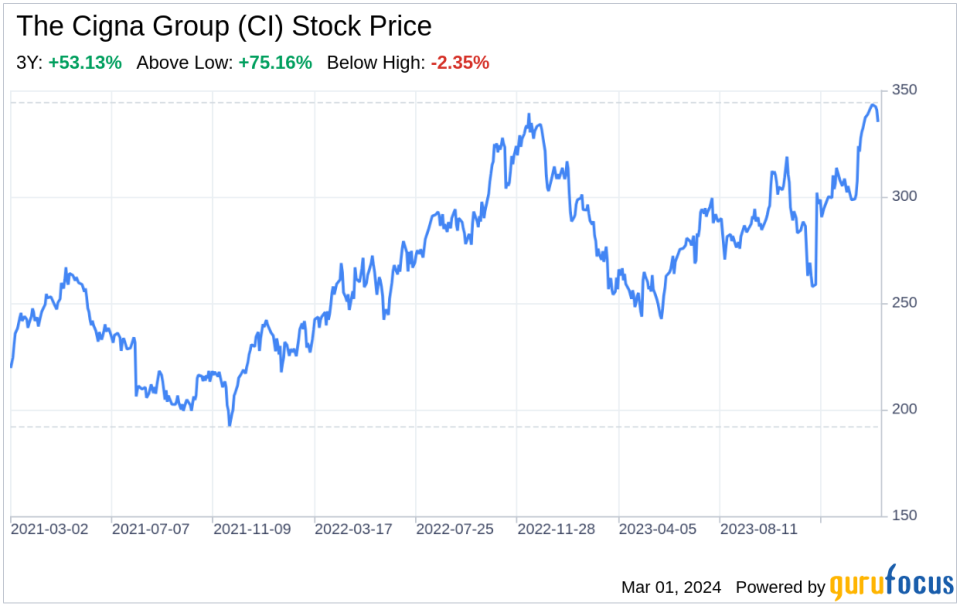Decoding The Cigna Group (CI): A Strategic SWOT Insight
Comprehensive SWOT analysis based on The Cigna Group's latest SEC 10-K filing.
Detailed exploration of The Cigna Group's strengths, weaknesses, opportunities, and threats.
Data-driven insights to inform investment decisions and understand The Cigna Group's competitive landscape.
Forward-looking strategies and potential impact on The Cigna Group's market position.
On February 29, 2024, The Cigna Group (NYSE:CI) filed its 10-K report, revealing a year of strategic maneuvers and financial performance. As a leading provider of pharmacy benefit management and health insurance services, The Cigna Group reported adjusted revenues of $51.2 billion and pre-tax adjusted income from operations of $4.5 billion for 2023. The company's strategic sale of its Medicare Advantage and other supplemental benefits businesses for $3.3 billion underscores a focus on optimizing its portfolio. With 18 million U.S. medical members and a recent contract win with Centene, The Cigna Group is poised for growth. This SWOT analysis delves into the intricacies of The Cigna Group's market position, leveraging the latest financial data to provide a comprehensive overview for investors.

Strengths
Market Position and Brand Reputation: The Cigna Group's strong market presence is bolstered by its comprehensive medical plan services and coordinated solutions. With a reported adjusted revenue of $51.2 billion in 2023, the company has demonstrated financial robustness. Its brand reputation, particularly after the strategic merger with Express Scripts, has solidified its standing in the PBM services sector, making it a trusted partner for health insurance plans and employers. The Cigna Group's largest PBM contract with the Department of Defense and the recent deal with Centene further reinforce its industry leadership.
Innovative Health Solutions: The Cigna Group's array of medical and specialty benefits, along with its focus on integrated, digital-first, data-driven programs, positions it at the forefront of innovation in health care. Its investment in AI technologies and predictive analytics enables the company to offer personalized and efficient health care solutions, driving better outcomes and customer engagement. The strategic investments in companies like VillageMD and CarepathRx Health Systems Solutions indicate The Cigna Group's commitment to expanding its capabilities in care delivery and enablement.
Weaknesses
Dependence on U.S. Market: Despite its strong presence, The Cigna Group's operations are heavily concentrated in the U.S., with approximately 93% of its employees based in the country. This geographic concentration could expose the company to market-specific risks, including regulatory changes and economic downturns. Diversifying its geographic footprint could mitigate this risk and provide more stable revenue streams.
Complex Regulatory Environment: The health insurance industry is subject to stringent regulations, including minimum MLR requirements and policy rate increase reviews by HHS. The Cigna Group's need to maintain compliance with these evolving regulations could impact its profitability and operational flexibility. Additionally, the sale of its Medicare Advantage business indicates a strategic shift that may require careful navigation to ensure continued compliance and market competitiveness.
Opportunities
Expansion into International Markets: The Cigna Group's International Health segment offers potential for growth outside the U.S. By leveraging its expertise in providing international plans to multinational employers and globally mobile individuals, the company can tap into new markets and diversify its revenue sources. Strategic partnerships and acquisitions could accelerate this international expansion.
Technological Advancements: The Cigna Group's investments in digital, data, and technology, including its AI Center of Enablement, position it to capitalize on the growing trend of digital health. By continuing to innovate and integrate new technologies, The Cigna Group can enhance its service offerings, improve customer experience, and gain a competitive edge in an industry that is increasingly reliant on tech-driven solutions.
Threats
Competitive Pressure: The health insurance and PBM sectors are highly competitive, with players vying for market share through innovation, cost-effectiveness, and quality of service. The Cigna Group faces competition from other major insurers and PBMs, which could impact its ability to retain and grow its customer base. Maintaining its competitive advantages, such as its provider networks and health advocacy capabilities, will be crucial for The Cigna Group's continued success.
Changing Healthcare Landscape: The healthcare industry is undergoing significant changes, driven by policy reforms, technological advancements, and evolving consumer expectations. The Cigna Group must adapt to these changes to remain relevant. Its ability to anticipate and respond to shifts in the healthcare landscape, such as the increasing demand for value-based care and telemedicine, will be a determinant of its future growth and sustainability.
In conclusion, The Cigna Group (NYSE:CI) exhibits a robust market position with a strong brand reputation and innovative health solutions. However, its reliance on the U.S. market and the complex regulatory environment present challenges that must be managed. Opportunities for international expansion and technological advancements offer pathways for growth, while competitive pressures and a changing healthcare landscape pose threats that require strategic foresight. The Cigna Group's forward-looking strategies, including its investments in AI and digital health, position it well to leverage its strengths and opportunities while addressing its weaknesses and threats.
This article, generated by GuruFocus, is designed to provide general insights and is not tailored financial advice. Our commentary is rooted in historical data and analyst projections, utilizing an impartial methodology, and is not intended to serve as specific investment guidance. It does not formulate a recommendation to purchase or divest any stock and does not consider individual investment objectives or financial circumstances. Our objective is to deliver long-term, fundamental data-driven analysis. Be aware that our analysis might not incorporate the most recent, price-sensitive company announcements or qualitative information. GuruFocus holds no position in the stocks mentioned herein.
This article first appeared on GuruFocus.
